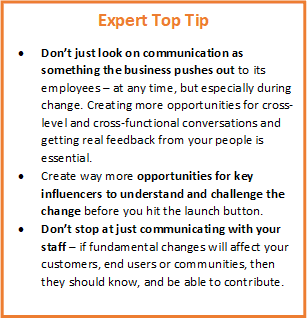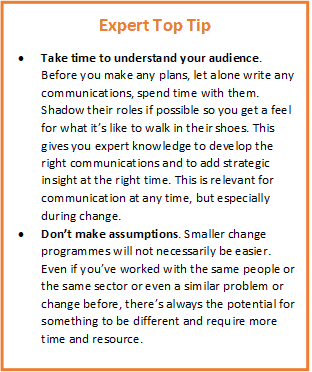When Comms Goes Bad: Mistakes not to make when communicating during change
“The single biggest problem in communication is the illusion that it has taken place.” – George Bernard Shaw
Whenever a business embarks on a period of change, it will (hopefully) involve an element of communication. This comms aspect can often play second fiddle to the changes themselves, but as anyone who has recently bought a Toblerone and was horrified to discover they’d been slimmed down will know, experiencing a change without feeling informed or consulted can be a jarring experience. Consumers didn’t feel consulted or informed by Mondelez, and were outraged at the diminished size of their favourite triangular chocolate.
Even when companies have the best intentions around communicating during change, they can still experience things not going to plan. So how can you identify what pitfalls to avoid and the key pieces of advice to follow? Well, we’ve done the hard work so you don’t have to. We spoke to some seasoned comms experts who have seen their fair share of change programmes and businesses in transition, to find out what happens When Comms Goes Bad, and their Top Tips for communicating successfully during change.
“The message needs to be realistic, and the tone needs to be true to the business”
J – Corporate communications writer with 30 years’ experience working with public and private sector clients.
“People can have a lot of negative emotions around change – they’re nervous about the future, they can be nervous about their jobs, and so they’re often cynical. So it’s really important for the business to be honest and to recognise that. One of the mistakes I’ve seen companies make is saying “This is who we are and this is what we’re doing”, and it’s not true, especially the “who we are” part – they’re not being honest with themselves or acknowledging what life is really like for their people. And people will seize on that.

“This doesn’t mean you have to dwell on the negatives – the communications absolutely can and should still be aspirational if you’re trying to achieve change, but you need to say “This is where we want to be (and why). We’re not there yet, but this is how we’re going to get there and this is how we need your help”.
Obviously engaging people in the changes themselves is important, but you should do the same for the communication. If you can incorporate language from interviews and conversations with people into the message then they’ll see it and think “Yeah, that is how I feel, they did listen”. It should be like a good leader speaking to you one-on-one – it needs to be positive, realistic, consistent and true, otherwise people will just see through it. And it must be backed up by action as part of a proper programme – it’s no good comms coming out saying “we’re going to do all these things” and then they don’t happen.”
“Communication mustn’t be an urgent afterthought”
Anne Griffiths (Business Manager, Newton Europe) – Communication and Engagement expert who has spent the last ten years leading employee communication for national and international business transformation programmes.
“Most comms professionals will have experienced a version of the scenario where a board director knocks on their door requesting ‘some comms’ the day before a big change announcement. The company has deprioritised strategic communication planning in favour of their implementation plan and suddenly they’re asking themselves: ‘What are we going to say to thousands of our people? How will we mobilise a significant proportion who may need to work differently next week to how they’re working this week? And, wait a second… aren’t our frontline teams our main routes into our customers?  Will our staff be equipped and willing to answer questions flying at them from end users?’ And they want the comms team to come up with the answers immediately. Luckily, this last minute tactic happens less and less these days; more organisations understand the value of integrating comms early and internal communication having a seat in the boardroom.
Will our staff be equipped and willing to answer questions flying at them from end users?’ And they want the comms team to come up with the answers immediately. Luckily, this last minute tactic happens less and less these days; more organisations understand the value of integrating comms early and internal communication having a seat in the boardroom.
“That’s not to say things couldn’t get better. The biggest issue I see is the tsunami approach to comms, with it all becoming frontloaded. Budgets get blown on the ‘big launch’ – a multi-media explosion, CEO roadshows, and a wave of noise, bells and whistles usually greeted with collective eye-rolls. The point here is that all the investment is in the kick-off rather than in gaining understanding and helping people move through the change with targeted, two-way communication opportunities. Employees who hear about change from their line manager are 9 x more likely to support it than if they read about it in a company channel – line managers hold much more sway over their teams than senior executives. And with the right dialogue with the right people at the right time, the proposed change itself might even get a rethink, and it can actually emerge more robust and really right for the organisation than before.”
“If you don’t understand who you’re engaging, you could actually create a workforce even more resistant to change”
Tom Shennan-Barker (Director, Charming Communications) – strategic communication and engagement consultant working across private and non-profit sectors.
“So often clients choose to use existing channels without considering how staff want to receive information and what the best format is for a particular message. People just aren’t keen on taking time to build insight to make a really informed decision, thinking that with existing channels it’s just so much easier to push something out. 
“One example of this was we had a really well executed piece of comms for a client during a large change programme – it had the why, the who, the when, and the implementation was smooth – but it just fell flat with the audience, and the reason was the channel. The client didn’t realise that their staff all saw noticeboards as ‘white noise’ because they were already used so much, and so they just didn’t engage with them. Once they did a proper assessment and realised face-to-face communication of the message was what people wanted, we had so much more success. But it added weeks on to the programme.
“The biggest thing I see people getting wrong is time; employers just underestimate how long it takes to get from Point A to Point B in a change programme. They generally plan their comms around a straightforward implementation, which rarely happens. It means that if things do go wrong or messages take longer to land there’s no contingency; they end up with big gaps where they’re just firefighting, and having to go back and ask for more resource.”
So, if you’re about to embark on a change programme (or are in the middle of one already), ask yourself: ‘what’s my Toblerone?’ Make sure that you have a clear strategy for your communication (but allow for unpredictability); that you take time to understand your people (how they really feel, how they want to receive information); that you keep up that dialogue; and crucially that do what you say you will.
Do you have any top tips or war stories to share about communications during change programmes? Get in touch at connect@connectwell.co.uk or on our LinkedIn page.







